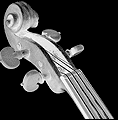

 Aristide Cavaillé-Coll, builder of organs for the great churches of Europe, was an ingenious innovator grounded in tradition. The sound of the late-19th-century master craftsman's majestic instruments – and his ability to balance respect for the past and technological trailblazing – are coming to life in Finney Memorial Chapel. Voicers from C.B. Fisk have worked through the winter and spring to ready the Conservatory's new 3,951-pipe Cavaillé-Coll-inspired symphonic organ for a September debut.  Excitement
is building to a crescendo. Excitement
is building to a crescendo.Professor of Organ Haskell Thomson, who directs Oberlin's keyboard studies division, is absolutely smitten with the new organ – the Opus 116. He is excited personally, of course, because he'll be able to play the great literature of the 19th and early 20th centuries he so loves. He also is excited for a larger – and, he allows, more important – reason: Conservatory students will get a chance to learn and play that great music in its original form. "It is very specifically a romantic organ in symphonic style and very specifically based on Cavaillé-Coll's work," he says. "It is absolutely awesome that something of this quality is being recreated here." The son and grandson of organ builders, Cavaillé-Coll was a trendsetter who never let enthusiasm for the new overwhelm his classically honed standards of tonal excellence. Oberlin's Opus 116 in turn balances emulation of the romantic-era builder's instruments with a judicious concern for the demands of 20th-century composition. A close examination of the organ shows 19th-century techniques and 20th-century technology in intimate association. Cavaillé-Coll's influence is evident in the layout of the pipe chests, employing a double chest design that allows a musician – using devices called ventil pedals – to deny wind to a portion of a chest until it is needed. Pressing the ventil pedal, then, has the same effect as a conductor pointing to the brasses, or, on the organ, calling into play the reed stops. Rich and brilliant sonorities can be built in this way. The ventil pedal option exists in French Mode, says Thomson. But the organ also features an updated American Mode, a thoroughly high-tech mechanism that allows a player to add and subtract stops in any configuration desired using computer technology. Tucked in the face of the console are the lighted red numbers of a digital display – part of the computerized system for shifting among stop combinations. The German firm Laukuff cast each of the new organ's towering, glowing front pipes with about 70 percent tin. Most of the interior pipes, made by Fisk, are cast of 95 percent tin. David C. Pike, Fisk's executive vice president and tonal director, says this is "the closest Fisk has come to replicating Cavaillé-Coll's characteristic 97 percent tin pipes." "It's the sound of Cavaillé-Coll's organs that we're really trying to recreate," he says. "And we're trying to create an instrument that will give students a chance to experience what it might have been like 120 years ago to play one of his instruments in France." The instruments in question were inseparably intertwined with romantic composition. Franck, Saint-Saëns, Widor, and Vierne wrote for Cavaillé-Coll's powerful and versatile organs. In turn, says Thomson, Cavaillé-Coll sought to build instruments that provided the means for creating music with a wide dynamic range, from the most ethereal pianissimo to a thundering fortissimo. Swell shades made dynamic nuances possible, and the symphonic orchestra inspired sonorities, but Cavaillé-Coll achieved these effects with techniques derived from his adherence to the long tradition of European organ building. In Paris, Cavaillé-Coll built organs at the Cathedral of Notre-Dame, Saint Sulpice, and Saint Denis, among many others. Unfortunately, as Paris fashion changed, some, although not all, of his creations were rebuilt – sometimes beyond recognition. The organ at Saint Sulpice is one that remains intact. Also, in out-of-the-way places – at Caen, Rouen, and Toulouse – some instruments survive little altered. Haskell Thomson went to France in spring 1980 to study Cavaillé-Coll organs that were in original condition. A McCandless grant funded the journey, which assisted Thomson's creation of a course in romantic and contemporary organ literature that focuses on the music of the Cavaillé-Coll tradition, on Cavaillé-Coll's influence on the musicians of the time and on future organ building. This Conservatory course has been offered regularly since 1981. Professor of Organ David Boe has twice taken contingents of Oberlin organ students to France so that they might study and play from this great tradition. The builders at C.B. Fisk have also scrutinized Cavaillé-Coll's instruments, examining their pipes and photographing their internal architecture. Fisk's designers had incorporated their insights in eclectic instruments, combining French romantic elements with components reflecting other eras. But Oberlin's Opus 116 has given the company its first chance "to unabashedly make an organ in the French symphonic style," says Fisk's president, Steven Dieck. The organ world's appreciation for Cavaillé-Coll has been heightened by the scholarly work of Fenner Douglass, a pioneer in the historical performance movement who graduated from Oberlin in 1942 and taught in the Conservatory from 1946 to 1974. Douglass' two-volume work, Cavaillé-Coll and the Musicians, is an extremely valuable resource for information on contracts the organ builder had made with churches during his lifetime, and for details on his interaction with the great musicians of the time. Douglass, in fact, was an original architect of Oberlin's collection of period instruments. A Touch of the 20th Century In a manner that Cavaillé-Coll himself surely would have endorsed, Opus 116's builders have judiciously applied 20th-century technology in creating their hand-built instrument. AutoCAD (computer-assisted design) mapped the organ's dimensions. The builders brought their computer and their AutoCAD files with them to Finney to help guide the assembly of each of the instrument's miniature-to-massive pipes. (The smallest is smaller than a child's finger. The largest measures 32 feet.) Go to Page 1 |
2 of A SYMPHONY OF OLD AND NEW
|